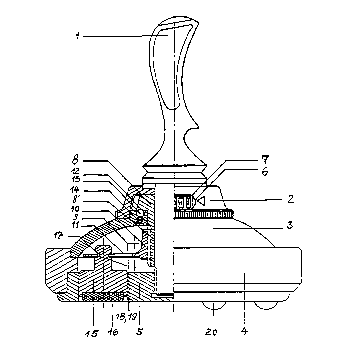Une partie des informations de ce site Web a été fournie par des sources externes. Le gouvernement du Canada n'assume aucune responsabilité concernant la précision, l'actualité ou la fiabilité des informations fournies par les sources externes. Les utilisateurs qui désirent employer cette information devraient consulter directement la source des informations. Le contenu fourni par les sources externes n'est pas assujetti aux exigences sur les langues officielles, la protection des renseignements personnels et l'accessibilité.
L'apparition de différences dans le texte et l'image des Revendications et de l'Abrégé dépend du moment auquel le document est publié. Les textes des Revendications et de l'Abrégé sont affichés :
| (12) Demande de brevet: | (11) CA 2222011 |
|---|---|
| (54) Titre français: | PIERRE DE CURLING DEMONTRANT DES CARACTERISTIQUES DE GLISSEMENT A REGLAGE CONTINU |
| (54) Titre anglais: | CURLING STONE FOR CURLING WITH CONTINUOUSLY VARIABLE GLIDING CHARACTERISTICS |
| Statut: | Réputée abandonnée et au-delà du délai pour le rétablissement - en attente de la réponse à l’avis de communication rejetée |
| (51) Classification internationale des brevets (CIB): |
|
|---|---|
| (72) Inventeurs : |
|
| (73) Titulaires : |
|
| (71) Demandeurs : |
|
| (74) Agent: | SMART & BIGGAR LP |
| (74) Co-agent: | |
| (45) Délivré: | |
| (86) Date de dépôt PCT: | 1996-05-22 |
| (87) Mise à la disponibilité du public: | 1996-11-28 |
| Licence disponible: | S.O. |
| Cédé au domaine public: | S.O. |
| (25) Langue des documents déposés: | Anglais |
| Traité de coopération en matière de brevets (PCT): | Oui |
|---|---|
| (86) Numéro de la demande PCT: | PCT/AT1996/000097 |
| (87) Numéro de publication internationale PCT: | WO 1996037268 |
| (85) Entrée nationale: | 1997-11-21 |
| (30) Données de priorité de la demande: | ||||||
|---|---|---|---|---|---|---|
|
Amélioration d'une pierre de curling connue sous le numéro de brevet autrichien 354,921. Une coquille de support (2), présentant une ou plusieurs ouvertures (6) pour rendre le mécanisme de freinage accessible, est placée en appui entre le manche (1) et le boîtier (3), la coquille présentant dans sa surface supérieure un trou central. Selon un modèle préféré, la console (9) du mécanisme de freinage s'avère un support essentiellement élastique de section transversale étoilée et pourvu, de préférence, de trois à six bras (11) présentant des fentes radiales décroissantes (18, 19) servant à recevoir les supports de surface de frein (15).
The present invention relates to an improvement of a curling stone
known from Austrian patent No. 354,921 wherein a support shell (2) provided
with one of more openings (6) for rendering the brake device accessible is
supportively placed between the handle (1) and the housing (3), the support
shell being provided in its upper surface with a central bore. In a preferred
embodiment, the bracket (9) of the brake device is an inherently resilient
support member of star-shaped cross-sectional configuration with preferably
three to six arms (11), radially narrowing slots (18,19) being provided in the
arms (11) for receiving the brake surface supports (15).
Note : Les revendications sont présentées dans la langue officielle dans laquelle elles ont été soumises.
Note : Les descriptions sont présentées dans la langue officielle dans laquelle elles ont été soumises.

2024-08-01 : Dans le cadre de la transition vers les Brevets de nouvelle génération (BNG), la base de données sur les brevets canadiens (BDBC) contient désormais un Historique d'événement plus détaillé, qui reproduit le Journal des événements de notre nouvelle solution interne.
Veuillez noter que les événements débutant par « Inactive : » se réfèrent à des événements qui ne sont plus utilisés dans notre nouvelle solution interne.
Pour une meilleure compréhension de l'état de la demande ou brevet qui figure sur cette page, la rubrique Mise en garde , et les descriptions de Brevet , Historique d'événement , Taxes périodiques et Historique des paiements devraient être consultées.
| Description | Date |
|---|---|
| Demande non rétablie avant l'échéance | 2000-05-23 |
| Le délai pour l'annulation est expiré | 2000-05-23 |
| Réputée abandonnée - omission de répondre à un avis sur les taxes pour le maintien en état | 1999-05-25 |
| Inactive : CIB en 1re position | 1998-03-02 |
| Inactive : CIB attribuée | 1998-03-02 |
| Symbole de classement modifié | 1998-03-02 |
| Inactive : Notice - Entrée phase nat. - Pas de RE | 1998-02-16 |
| Inactive : Inventeur supprimé | 1998-02-16 |
| Demande reçue - PCT | 1998-02-13 |
| Demande publiée (accessible au public) | 1996-11-28 |
| Date d'abandonnement | Raison | Date de rétablissement |
|---|---|---|
| 1999-05-25 |
Le dernier paiement a été reçu le 1998-05-21
Avis : Si le paiement en totalité n'a pas été reçu au plus tard à la date indiquée, une taxe supplémentaire peut être imposée, soit une des taxes suivantes :
Veuillez vous référer à la page web des taxes sur les brevets de l'OPIC pour voir tous les montants actuels des taxes.
| Type de taxes | Anniversaire | Échéance | Date payée |
|---|---|---|---|
| Taxe nationale de base - générale | 1997-11-21 | ||
| TM (demande, 2e anniv.) - générale | 02 | 1998-05-22 | 1998-05-21 |
Les titulaires actuels et antérieures au dossier sont affichés en ordre alphabétique.
| Titulaires actuels au dossier |
|---|
| JOSEF PAUL HERZ |
| Titulaires antérieures au dossier |
|---|
| S.O. |